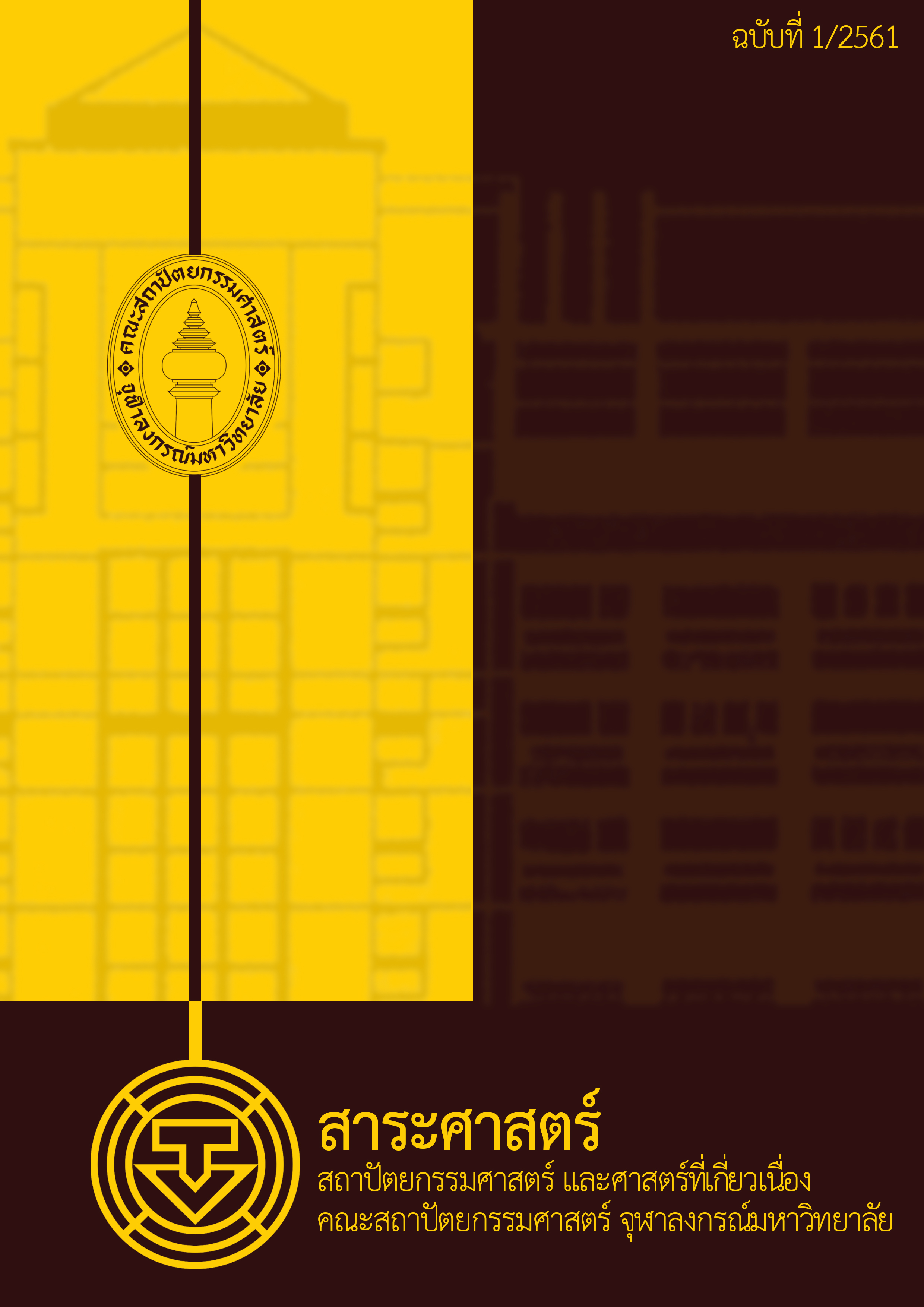Development of Building Information Modeling to Calculate the Overall Thermal Transfer Value at Schematic Design Stage
Main Article Content
Abstract
According to the Energy Conservation Promotion Act II B.E. 2007, Overall Thermal Transfer Value (OTTV) could be calculated in various ways such as manual calculation or using BEC V.1.0.6. program. However, it was found that the current program would input a lot of data from the designers and can be changed all the time. This can increase to errors in the input data. To protect this problem, the algorithm in Autodesk Revit program coupled with the Dynamo add-ins with the goal to generate commands capable of controlling and retrieving data, and mathematical calculations, which can generate the result of the OTTV equation in accordance with The Ministerial Regulation of Energy B.E. 2009 has been developed, by the steps in studying from relevant literatures and survey questionnaires to seek the current problems then the data were developed program and compared the calculation results. Moreover, the result of this development is the add-ins in Autodesk Revit program for estimating OTTV in the schematic design stages in which users can adjust the design and the value would then be changed automatically, thus reducing the overlapping processes. Compared to the BEC V.1.0.6 program, it was found that the estimated OTTV value generated by the Dynamo add-ins has an approximate deviation of ±1.0 % due to the different linear interpolations which cause the difference in the results.
Article Details
References
CURT. (2004). Collaboration, Integrated Information and the Project Lifecycle in Building Design, Construction and Operation. Cincinnati, OH.
Schueter, A.,and Thessling, F. (2008). Building information model based energy/exergy performance assessment in early design stages. Automation in Construction, 18(2): 153-163.
The Dynamo Primer. What is Visual Programming? [Online]. 2017. Available from: https://dynamoprimer.com/ [2017, November 27]
U.S.GSA. 3D–4D Building Information Modeling. [Online]. 2017. Available from: https://www.gsa.gov/bim/ [2017, November 27]
กรมพัฒนาพลังงานทดแทนและอนุรักษ์พลังงาน. (2552). คู่มือคําอธิบายพระราชบัญญัติ การส่งเสริมการอนุรักษ์พลังงาน พ.ศ. ๒๕๓๕ (ฉบับแก้ไขเพิ่มเติม) สำหรับโรงงานควบคุมและอาคารควบคุม. กรุงเทพฯ: กระทรวงพลังงาน.
กรมพัฒนาพลังงานทดแทนและอนุรักษ์พลังงาน. คู่มือการใช้งานโปรแกรม BEC v.1.0.6. [ออนไลน์]. 2560. แหล่งที่มา: https://www.2e-building.com/ [27 พฤศจิกายน 2560]
กวิน ตันติเสวี. (2555). โครงการแบบจำลองสารสนเทศเพื่อประเมินประสิทธิภาพการใช้พลังงานของอาคาร. กรุงเทพฯ: สำนักงานคณะกรรมการการอุดมศึกษา สำนักงานกองทุนสนับสนุนการวิจัย และ มหาวิทยาลัยเทคโนโลยีพระจอมเกล้าพระนครเหนือ.
ชนิกานต์ ยิ้มประยูร. (2558). แนวทางในการพัฒนาโปรแกรมจำลองการใช้พลังงานในอาคารสำหรับประเทศไทย วารสารวิชาการ คณะสถาปัตยกรรมศาสตร์ จุฬาฯ, 64: 49-65.
ธารา จำเนียรดำรงการ. (2555). การพัฒนาโปรแกรมประมาณค่าการถ่ายเทความร้อนรวมของผนังด้านนอกอาคาร (OTTV) และค่าการถ่ายเทความร้อนรวมของหลังคาอาคาร (RTTV). วิทยานิพนธ์ปริญญาวิทยาศาสตรมหาบัณฑิต, สาขาวิชาคอมพิวเตอร์เพื่อการออกแบบสถาปัตยกรรม ภาควิชาเทคนิคสถาปัตยกรรม บัณฑิตวิทยาลัย มหาวิทยาลัยศิลปากร
ประกาศกระทรวงพลังงาน เรื่อง หลักเกณฑ์และวิธีการคำนวณในการออกแบบอาคารแต่ละระบบ การใช้พลังงานโดยรวมของอาคาร และการใช้พลังงานหมุนเวียนในระบบต่าง ๆ ของอาคาร พ.ศ. 2552. (2552, 28 สิงหาคม). ราชกิจจานุเบกษา. เล่ม 126 ตอนพิเศษ 122 ง. หน้า 21-58
สมาคมสถาปนิกสยามฯ. (2558). คู่มือปฏิบัติวิชาชีพ แนวทางการใช้งานแบบจำลองสารสนเทศอาคาร สำหรับประเทศไทย (Thailand BIM Guideline). กรุงเทพฯ: สมาคมสถาปนิกสยาม ในพระบรมราชูปถัมภ์.


